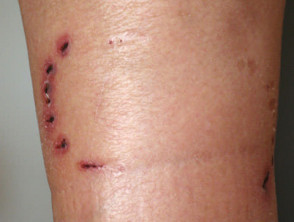Introduction
Veterinarians and veterinary nurses provide an important service globally for pets, agricultural stock, service animals and exotic animals. However, the nature of veterinary work puts these professionals at risk for a variety of job-related skin disorders. Safe Work Australia, part of the Australian Government’s occupational health and safety service programme, listed veterinary work as being in the top 20 professions in regard to rates of skin disorders and skin disease.
Why are veterinarians and veterinary nurses at such high risk of skin disorders?
Factors that contribute to the high-risk nature of veterinary work include:
- Exposure to blood-borne and zoonotic pathogens
- The use of needles and other sharps in the regular course of veterinary work
- Exposure to cleansing and disinfecting agents and other potentially irritating chemicals
- Wetwork, or prolonged exposure of the hands to water
- Exposure to weather extremes and to solar radiation.
Understanding occupational skin disorders
Occupational skin disease is an umbrella term that refers to dermatological conditions that develop or are exacerbated by the nature of an individual’s work. Occupational skin disorders and skin diseases are the most common form of work-related health disorder. Allergic contact dermatitis or irritant contact dermatitis account for about 79–90% of occupational skin disorders. Occupational skin disorders have a strong economic impact due to missed days of work, medical costs, workers’ compensation and sometimes a need to change professions due to treatment-resistant skin disorders. Dermatoses develop when the nature of a person’s work breaches the natural barriers of the skin and makes the skin more vulnerable to breakdown and/or infection.
Occupational skin disorders affecting veterinarians and veterinary nurses
Contact dermatitis
Contact dermatitis is a frequent complaint among veterinary workers.
- Both allergic contact dermatitis and irritant contact dermatitis arise.
- The main causes are wet work and exposure to cleansers, disinfectants, latex gloves, and other irritants or allergens.
Bite injuries
Animal bites are common in veterinary practice.
- Cats and dogs are responsible for most bites.
- It is estimated that 3–18% of dog bites and 28–80% of cat bites become infected.
- Pasteurella is the most common secondary bacterial infection from animal bites.
- Bacterial infections can result in abscesses, meningitis and sepsis.
- Bites can often be prevented by the proper use of restraints.
- Wounds should be promptly treated by thorough washing and/or oral antibiotics as indicated.
- Cat scratches can lead to cat scratch fever.
Mechanical injuries
Mechanical injury is another common risk for veterinary workers. This is largely due to use of syringes, lancets and other sharps.
- The transmission of disease or secondary infection can result.
- The risk of mechanical injury can be prevented with safe handling, use and disposal of sharps.
Fungal infections
Common fungal infections include tinea corporis (ringworm) and blastomycosis.
- Tinea corporis is caused by a Microsporum or Trichophyton species. The incidence of tinea corporis in veterinary workers can be managed through the quarantine of infected animals, use of personal protective equipment, proper hygiene procedures, and cleansing of the work area.
- Blastomycosis is caused by a Blastomyces species and results in skin lesions, chronic cough, breathlessness, anorexia and weight loss.
Other infections
Veterinarians may be prone to other specific infections associated with agriculture and animal husbandry. Examples include:
Sun exposure
Sun exposure or sunburn is another occupational hazard for veterinary workers.
-
- Exposure to ultraviolet (UV) radiation occurs during fieldwork, especially in veterinary practices dealing with large animals.
- Sun exposure causes skin ageing and increases the risk of skin cancer, including melanoma.
- The use of sun protective clothing, hats, sunscreen, and sunglasses can reduce the risk.
Skin disorders in veterinarians and veterinary nurses
Workplace risk assessment
In order to provide a safe environment for veterinary workers, a workplace risk assessment should focus on:
- The physical work environment, including lighting, safe work spaces, up-to-date surgeries, etc.
- Protocols for infection control, use of personal protective equipment, and sharps handling and disposal
- Protocols to handle animals
- Maintenance of laboratory and surgical equipment
- Knowledge of the dangers, usages and safety information on all chemicals in the facility, via documents such as safety data sheets and material safety data sheets.
Personal protective equipment
Personal protective equipment for workers in a veterinary clinic should include the following:
- Gloves (preferably non-latex to prevent sensitisation)
- Goggles
- Protective aprons or other protective clothing.
In order to be effective, veterinary employees must be educated on the proper donning, use and disposal of personal protective equipment.
Hand care advice for veterinary workers
Good hand care is important to the health of veterinarians and veterinary nurses and may include:
- Appropriate personal protective equipment and tools to minimise exposure to hazards
- Washing and drying hands thoroughly when appropriate and also using alcohol-based hand gels or hand sanitisers as indicated
- The use of emollients and moisturisers to maintain the skin barrier
- Treating skin disorders and injuries promptly and seeking professional medical help if needed.
Diagnosis and treatment of occupational skin disorders
The diagnosis of an occupational skin disorder should be based on:
- A physical examination, with an emphasis on presentation and affected areas
- The individual’s medical history, including a history of dermatological or immunological disorders
- An occupational history, including the specific nature of the individual’s work, their potential for contact with allergens or irritants, workplace safety education and protocols, and length of time on the job
- Patch testing if allergies are suspected.
Treatment can include:
- Use of topical and/or oral antifungals for fungal infections
- Wound cleansing and care for animal bites or sharps injuries
- Standard management of dermatitis with emollients and topical corticosteroids
- Referral to a dermatologist if skin problem persists or resists simple treatments.
- Immunisation or boosters to prevent tetanus or rabies
